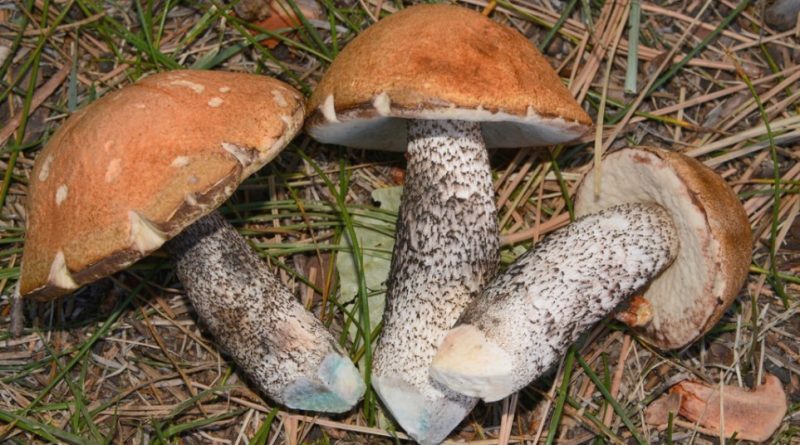Leccinum versipelle
Leccinum versipelle
The Orange Birch Bolete (Leccinum versipelle (Fr. & Hök) Snell) is a basidiomycete mushroom belonging to the Boletaceae family.
Systematic –
From the systematic point of view it belongs to the Domain Eukaryota, Kingdom Fungi, Basidiomycota Division, Class Basidiomycetes, Order Boletales, Family Boletaceae and therefore to the genus Leccinum and to the species L. versipelle.
The terms are synonyms: Boletus floccopus Rostk. and Boletus rufescens Pilát.
Etymology –
The term Leccinum comes from (i) líceus, derived from ílex, -icis leccio: from the holm oak, related to the holm oak. The specific versipelle epithet is to be turned, changed, modified and from skin péllis.
Geographic Distribution and Habitat –
The Leccinum versipelle is a fungus that grows solitary or gregarious both on sandy, slightly siliceous, clayey soils, where it is more easily found in mountain environments up to 2000 meters. Mycorrhizal shape with Birch.
Recognition –
Orange Birch Bolete is recognized for its firm and meaty hat at a young age and then soft, 8-18 cm in diameter, hemispherical when young, convex to convex when mature. The margin is involved, particularly in young carpophores, with fringes exceeding the tubules up to 4 millimeters, sometimes absent in mature specimens. The cuticle is brownish-yellowish, sometimes whitish with shades of apricot or rose. The tubules are attached, from segmentiform to venticose, 8-22 mm long, from white-yellowish to gray-brownish, purple-grayish to pressure.
The pores are small (0.5 mm in diameter), round, concolorous to the tubules, turn to brown when pressed. The Stem is full, hard, thickened at the base and sometimes curved, of a greyish-white color with fine and evident blackish gray scales, stained with greenish blue at the base. The meat is white, firm in fresh specimens; fibrous in the stem, turns to pink with shades of violet-blackish, with a light, grateful smell and sweetish taste.
Under the microscope, spores of 11.5-16.5 x 3.6-4.0 μm, spindle-shaped, pale brown-purple in color, with conical apex and evident overheating depression are noted. The basidia are 22-34 x 6.5-11 μm, clavate, generally tetrasporic. Cystids measure 22-45 x 7-11 μm, often lageniform, utriform or clavate, sometimes with a dull and sharp apex. The caulocystides are 39-70.5 x 8.5 μm, fusiform, utriform, sometimes conical or clavate, with a generally obtuse apex.
Cultivation –
Orange Birch Bolete is not a cultivated mushroom.
Uses and Traditions –
The Leccinum versipelle is a fungus of good edibility but to which it is advisable to eliminate the stem as it is fibrous and of mediocre quality and to also discard the hymenophore as slimy.
Preparation Mode –
Like most of the leccins, once harvested the stem must be discarded as fibrous and stringy and also the hymenophore as slimy. In addition, the oldest leccini tend to darken especially in the tubules, and it is therefore advised not to pick them up and keep only the younger ones. In addition, for their consumption necessarily require adequate cooking. Therefore, before using it, it is important to let the leccini mushrooms boil in their broth. Do not worry if they have been cut, or they change color after cooking. In fact, by their characteristic, they tend to have a darker color and is therefore an absolutely normal phenomenon. They can normally be stored in the freezer after cooking or cut and dried, but this does not exclude that they should be cooked when they are used.
The Leccini mushrooms are well sautéed in a pan, that is sautéed with a little oil, garlic and some aromatic herbs that exalt the already fragrant smell and their sweetish taste. Such mushrooms, having a big hat, are excellent for being stuffed, in doing so you can use vegetables, cheese, minced meat, sausage and even fish; the choice of filling depends exclusively on personal taste. In turn they can also be an ingredient to flavor the stuffing of other vegetables such as cabbages. Another way to cook leccini mushrooms and get an exceptionally good second course is frying. After having given it the right breading, passing in flour, egg and breadcrumbs, they are allowed to fry in a pan with the hot oil and the result will be crispy and delicious. Not even the possibility of preparing excellent sauces or soups that go to the wedding with the low temperatures of the season, and finally you can not forget the usual first course, namely risotto.
Guido Bissanti
Sources
– Wikipedia, the free encyclopedia.
– Cetto B., 2008. Real mushrooms, Saturnia, Trento.
– Pignatti S., 1982. Flora d’Italia, Edagricole, Bologna.
– Conti F., Abbate G., Alessandrini A., Blasi C. (edited by), 2005. An annotated checklist of the Italian vascular flora, Palombi Editore.
Warning: Pharmaceutical applications and alimurgical uses are indicated for informational purposes only and do not in any way represent a medical prescription; there is therefore no liability for their use for curative, aesthetic or food purposes.


